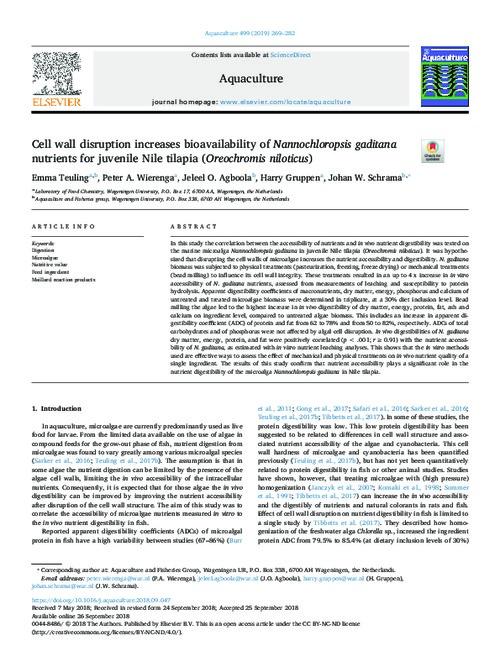Cell wall disruption increases bioavailability of Nannochloropsis gaditana nutrients for juvenile Nile tilapia (Oreochromis niloticus)
Abstract
In this study the correlation between the accessibility of nutrients and in vivo nutrient digestibility was tested on the marine microalga Nannochloropsis gaditana in juvenile Nile tilapia (Oreochromis niloticus). It was hypothesized that disrupting the cell walls of microalgae increases the nutrient accessibility and digestibility. N. gaditana biomass was subjected to physical treatments (pasteurization, freezing, freeze drying) or mechanical treatments (bead milling) to influence its cell wall integrity. These treatments resulted in an up to 4 x increase in in vitro accessibility of N. gaditana nutrients, assessed from measurements of leaching and susceptibility to protein hydrolysis. Apparent digestibility coefficients of macronutrients, dry matter, energy, phosphorus and calcium of untreated and treated microalgae biomass were determined in triplicate, at a 30% diet inclusion level. Bead milling the algae led to the highest increase in in vivo digestibility of dry matter, energy, protein, fat, ash and calcium on ingredient level, compared to untreated algae biomass. This includes an increase in apparent digestibility coefficient (ADC) of protein and fat from 62 to 78% and from 50 to 82%, respectively. ADCs of total carbohydrates and of phosphorus were not affected by algal cell disruption. In vivo digestibilities of N. gaditana dry matter, energy, protein, and fat were positively correlated (p < .001; r = 0.91) with the nutrient accessibility of N. gaditana, as estimated with in vitro nutrient leaching analyses. This shows that the in vitro methods used are effective ways to assess the effect of mechanical and physical treatments on in vivo nutrient quality of a single ingredient. The results of this study confirm that nutrient accessibility plays a significant role in the nutrient digestibility of the microalga Nannochloropsis gaditana in Nile tilapia

